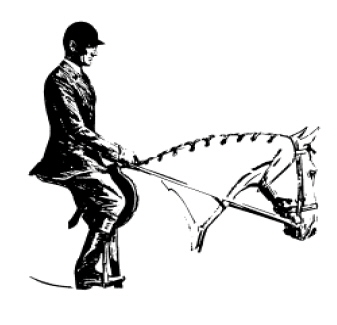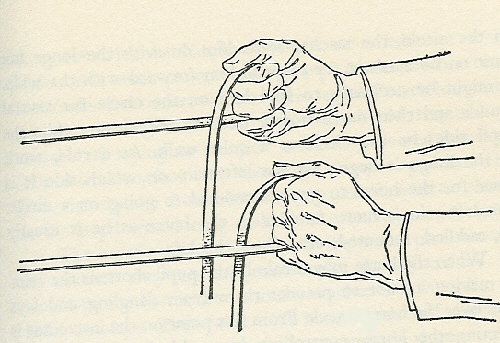IMEHA (International Model Equine Hobbyists Association) was an online photo showing site that existing until 2018. Included on the site were these guidebooks for judging and showing model horses in Performance classes. MEPSA has obtained permission to share the info contained in the guides.
Scoring :: Point Deducts :: Tack :: Rider :: Patterns :: Set-Up Options :: Photo Examples
A doll rider is required for this class. Entries may depict either flat work or Equitation Pattern (please state pattern # and step). The class is judged 80% on the rider and 20% on the horse. Hunt Seat Equitation is an evaluation based on the ability of a rider to perform various maneuvers in harmony with his/her horse. The horse is judged on it’s ability to be a pleasure style mount. The poll should be level with, or slightly above the withers, to allow proper impulsion behind. The head should not be carried behind the vertical, giving the appearance of intimidation, or be excessively nosed out, giving a resistant appearance.
Horses are asked to walk, trot, canter and sometimes hand gallop both directions of the arena, to stand in a line-up, rein-back and for a possible pattern consisting of other movements at the direction of the judge. Entries should work with a smooth regular gait, a natural willing and responsive headset; not necessarily fully flexed at the poll depending upon breed, conformation and style. They should show a forward – going way of impulsion and conformation consistence with a smooth and sustainable ride such a s a well-sloped shoulder, good pasterns, and a supple back with well-developed hind quarters. The demeanor of the horse (model) should be of happy and obedient participation in the class.
Some judges require a pattern in additional to rail work. When a pattern is used it is under the following guidelines:
All patterns must include a trot and canter. Horses’ gaits are to be ridden with the same cadence and speed as you would find in the rail phase.
Class Procedure:
Exhibitors may be worked individually from the gate or they may all enter at once, but a working order must be drawn regardless. The entire class, or only the finalists, must work at all three gaits at least one direction of the arena. Rail work can be used to break ties and possibly adjust placings. Individual works may be compromised of any of the following:
Group #1: Walk, Sitting Trot, Extended Trot, Posting Trot, Canter, Circles, Figure 8, Halt, Back, Sidepass, Address Reins, Demonstrate Change of Diagonal.
Group #2: Serpentine (Trot or Canter), Turn on Haunches or Forehand, Leg-Yield, Flying or Simple Change of Lead.
Group #3: Canter and Hand Gallop in a straight or curved line, Counter-Canter Figure 8, Drop or Pick-up Irons without stopping. A turn on the forehand to the right is accomplished by moving haunches to the left. A forehand turn to the left is accomplished by moving haunches to the right. If riders are asked to drop their irons, they can leave them down or cross them over the withers. When performing a leg-yield, the horse should move forward and lateral in a diagonal direction with the horse’s body straight with a slight flexion of the head in the opposite direction of lateral movement. When a horse yields to the right the head is slightly (just to see the eye of the horse) to the left. A horse yielding to the left the head is slightly flexed to the right.
Basic Position:
(1) Hands should be over and in front of horse’s withers, knuckles thirty degrees inside the vertical, hands slightly apart and making a straight line from horse’s mouth to rider’s elbow. Method of holding reins is optional, and bight of reins may fall on either side. However, all reins must be picked up at the same time.
(2) The eyes should be up and shoulders back. Toes should be at an angle best suited to rider’s conformation; heels down, calf of leg in contact with horse. Iron should be on the ball of the foot and must not be tied to the girth.
THE WALK: Should be a 4-beat gait with the rider in a vertical position with a following hand.
THE POSTING TROT: Figure 8 at trot, demonstrating change of diagonals. At left diagonal, rider should be sitting the saddle when left front leg is on the ground; at right diagonal rider should be sitting the saddle when right front leg is on the ground; when circling clockwise at a trot, rider should be on left diagonal; when circling counter-clockwise, rider should be on right diagonal. The rider should close his/her hip angle to allow his/her torso to follow the horizontal motion of the horse. The upper body should be inclined about 20 degrees in front of the vertical.
SITTING TROT AND CANTER: At the sitting trot the upper body is only slightly in front of the vertical. At the canter the body should be positioned slightly more in front of the vertical. As the stride is shortened, the body should be in a slightly more erect position.
TWO-POINT POSITION: The pelvis should be forward, but relaxed, lifting the rider’s weight off the horse’s back and transferring the weight through the rider’s legs. In this position the two points of contact between horse and rider are the rider’s legs. Hands should be forward, up the neck, not resting on the neck.
HAND GALLOP: A three-beat, lengthened canter ridden in two-point position. The legs are on the horse’s sides while the seat is held out of the saddle. When at the hand gallop, the rider’s angulation will vary somewhat as the horse’s stride is shortened and lengthened. A good standard at a normal hand gallop should be about 30 degrees in front of the vertical.
Some breeds have a distinct way of going that represent the huntseat standard for their breed. An example is the BHR Hunter, which is moving in a way that typifies the stock-type hunter but is not indictive of the movement of a sport-type huntseat pleasure mount. Huntseat Arabians tend to have slightly more action, although excessive action should be penalized. Entries that make reference to a breed association or particular national standard (AQHA, USFE, etc.) on the comment line saying that should get extra credit if the model is clearly performing to the standard.
Hunters under saddle should be suitable to purpose. Hunters should move with long, low strides reaching forward with ease and smoothness, be able to lengthen stride and cover ground with relaxed, free-flowing movement, while exhibiting correct gaits that are of the proper cadence. The quality of the movement and the consistency of the gaits is a major consideration. Horses should be obedient, have a bright expression with alert ears, and should respond willingly to the rider with light leg and hand contact. Horses should be responsive and smooth in transition. When asked to extend the trot or hand gallop, they should move out with the same flowing motion. The poll should be level with, or slightly above, the withers to allow proper impulsion behind. The head position should be slightly in front of, or on, the vertical.
You Score IMEHA Hunt Seat Equitation on the following basis:
The horse is scored with faults to be scored according to severity:
(1) Quick, short or vertical strides
(2) Being on the wrong lead
(3) Breaking gait
(4) Excessive speed at any gait
(5) Excessive slowness in any gait, loss of forward momentum
(6) Failure to take the appropriate gait when called for
(7) Head carried too high
(8) Head carried too low (such that poll is below the withers)
(9) Overflexing or straining neck in head carriage so the nose is carried behind the vertical
(10) Excessive nosing out
(11) Failure to maintain light contact with horse’s mouth
(12) Stumbling
(13) If a horse appears sullen, dull, lethargic, emaciated, drawn or overly tired
(14) Consistently showing too far off the rail
Faults which will be cause for disqualification, except in novice amateur or novice youth, which shall be faults scored according to severity:
(1) Head carried too low (such that poll is below the withers consistently)
(2) Overflexing or straining neck in head carriage so the nose is carried behind the vertical consistently
At the option of the judge, all or just the top 12 horses may be required to hand gallop, one or both ways of the ring. Never more than 12 horses to hand gallop at one time. At the hand gallop, the judge may ask the group to halt and stand quietly on a free rein (loosened rein).
Rider is scored with faults to be scored according to severity:
(1) Incorrect hands on rein.
(2) Loose of direct contact on reins.
(3) Incorrect heels of rider
(4) Incorrect balance of seat, shoulders, toes, ankles or poor seat
(5) Balls of feet incorrectly placed in irons
(6) No direct line on side profile of body
(7) Incorrect inclination of body at gait represented
(8) Incorrect attire
(9) failure by exhibitor to wear correct number in visible manner
(10) touching horse
(11) grabbing any part of the saddle
(12) cropping or spurring in front of the shoulder
(13) incorrect diagonal and/or incorrect lead
Disqualifications (should not be placed) include:
(1) Use of prohibited equipment
(2) Knocking over the cone or going off pattern
SUGGESTED SCORING may be on a basis of 0-20 with 1/2 point increments acceptable, an approximate breakdown follows:
20: Excellent equitation including body position and use of aids. Pattern is performed promptly, precisely and smoothly. 18-19: Generally excellent performance with one minor fault in appearance and position of exhibitor or execution of the pattern (performance).
16-17: Generally good pattern execution and equitation with one minor fault in precision or execution of pattern (performance), or appearance and position of exhibitor.
14-15: Average pattern that lacks quickness or precision, or rider has obvious equitation flaws that prevent effective equitation, or commits two or three minor faults in the performance or appearance and position of exhibitor.
12-13: One major fault or several minor faults in the performance and/or appearance and position of exhibitor that precludes effective communication with the horse.
10-11: Two major faults or many minor faults in the performance or appearance and position of exhibitor.
6-9: Several major faults or one severe fault in the performance, or appearance and position of exhibitor. Exhibitor demonstrates a complete lack of riding ability or commits a severe fault in the performance or appearance and position of exhibitor.
1-5: Exhibitor commits one or more severe faults in the performance, or appearance and position of exhibitor, but does complete the class and avoids disqualification.
Hunt Seat Doll Rider:
Rider should have a workmanship appearance, seat and hands, light and supple. Hand should be over and in front of horse’s withers, knuckles 30 degrees inside the vertical, hand slightly apart and making a straight line from the horse’s mouth to rider’s elbow. Method of holding reins is optional. All reins are to be picked up at the same time. Eyes should be up with shoulders back, toes slightly out and ankles flexed in. Heels should be down and calf or leg in contact with horse and slightly behind girth.
The rider should sit in a comfortable, balanced, and relaxed manner while maintaining an erect upper body with eyes up and looking forward.
The rider’s legs should have a slight bend and hang beneath the rider such that when viewed from a profile, a straight line (approximately) can be drawn through the rider’s ear, shoulder, hip and heel.
The irons should be placed under the balls of the feet and not under the toe or against the heel.
Toes should be turned only slightly out with ankles flexed in toward the horse.
The lower leg should be held such that light contact would be maintained with the horse.
Arms and hands should be held in a comfortable, relaxed manner with upper arms held in a straight line with the body. The elbow is bent such that the lower arm and hands are in a straight line to the bit.
Hands should be slightly over and in front of the withers with knuckles 30 degrees inside the vertical.
Position in Motion;
At the walk and slow trot, body should be vertical with slight motion in the saddle.
At a posting trot, the body should be inclined forward with slight elevation in the saddle.
At the canter, the body should be halfway between the posting trot and the walk.
At the gallop, and while jumping, the body should be at a similar inclination as when at a posting trot.
Extra Credit Should Be Given If:
(1) Rein contact is steady but gentle at all times. It is referred to as ‘direct contact’ On a model entry this can be achieved by using sticky wax and makes the rein go in a direct straight line from the bit to the rider’s hand with no slack in the rein.
(2) Mane and tail braided with complementary color also should receive extra credit.
(3) an Entry Number is shown on saddle blanket or on rider’s back.
Points Should Be Deducted If:
(1) Model exhibits excessive speed for gait assigned.
(2) Model is on the wrong lead.
(3) Model appears to display a slowness in any gait or loss of forward momentum resulting in an animated and/or artificial gait at the lope.
(4) Model’s head is carried too high.
(5) Model’s head carried too low; tip of ear below the withers.
(6) Model is over flexed or has a strained neck in head carriage, so the nose is carried behind the vertical.
(7) Model displays excessive nosing out.
(8) Model displays an open mouth excessively.
(9) Rider uses spurs forward of the heart girth.
(10) Model appears sullen, dull, lethargic, emaciated, drawn or overly tired.
(11) Model appears agitated; has ears back, tail twirled, etc.
(12) Model displays quick, choppy or pony strides.
(13) Reins are draped and not a direct contact.
Required Tack:
Forward seat saddle with a string or leather girth and bridles of matching leather with a cavesson noseband and bit, usually a snaffle bit. Most bits are legal however (snaffles of all types, pelhams and double bridles), it is assumed however that the rider is not relying upon a strong bit to control the horse, therefore a snaffle is recommended for this class. In most countries horses are shown with a white fitted saddle pad (called a numnah) in England though horses are shown without one and just the bare saddle on the horse’s back. On the West Coast in California is style of riding without a pad under the saddle is also often seen. Stock Hunt Bridles generally have a white lining under the browband and noseband under the leather on the bridle. Bridles may be laced, braided or plain. Entries are often braided (usually on the right side of neck). Breast plates and cruppers are legal tack for Huntseat Equitation, but their presence indicates that the horse is less than ideally shaped and therefore requires mechanical assistance to keep the saddle in position. Showers should be discouraged from using these items for the ‘effect’.
Optional: Boots and leg wraps are optional.
Prohibited Tack:
Martingales, Side Reins, Rein Stoppers, Figure-8, Flash and Drop Nosebands or other devices for controlling the headset are forbidden.
Rider: English Attire
Hunt Seat Attire
A. Riders must wear boots, breeches, coat, and hunt cap
B. A hunt hardhat cap or a hardhat derby is acceptable. All colors are acceptable with preference for traditional conservative colors.
C. Coats should be any tweed or melton (conservative wash jackets in season) acceptable for hunting. No Red Hunt Coats.
D. High English boots or jodhpurs and jodhpur or paddock boots
E. Long or short sleeve shirts with ties or chokers are preferred. Choker pins are acceptable.
F. Gloves are optional.
Hunt Seat Equitation Patterns:
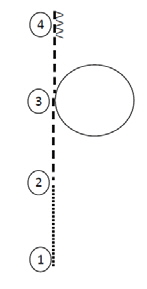
Hunt Seat Equitation Pattern #1
1. Walk from cone 1 to cone 2.
2. Trot on left diagonal to cone 3.
3. Canter small circle on right lead.
4. Trot on right diagonal to cone 4.
5. Stop and back one horse length at cone 4.
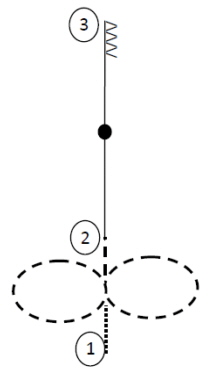
Hunt Seat Equitation Pattern #2
1. Walk from cone 1 midway to cone 2.
2. Trot a figure 8 starting to the left.
3. At cone 2 canter in left lead.
4. Midway to cone 3 do simple lead change.
5. Stop and back one horse length at cone 3.
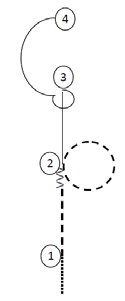
Hunt Seat Equitation Pattern #3
1. Walk to cone 1.
2. Sitting trot from cone 1 to cone 2.
3. At cone 2, do circle to the right at posting trot on left diagonal.
4. At cone 2, stop and back one horse length.
5. Canter on left lead to cone 3.
6. Stop.
7. 270 degree turn on forehand to the right.
8. Canter on right lead to cone 4.
9. Stop.
Set-Up Options:
Arena Fencing Required (Indoor or Outdoor Arena)
Types of Fencing Allowed:
- Painted or Natural
- Post and Rail
- Post and Plank
- Chain Link
- Solid Plyboard
- Plyboard with Top Rail
- Post with Drape Rope
- Stock Tube Pipe Rail
- Interior Arena Wall
Footing Required:
- Dirt
- Sand
- No rock base
Backboard or Natural Setting (Indoor or Outdoor)
Examples of the Four Breed Divisions:

IMEHA Hunt Seat Equitation
Stock Breed Entry
Adrenna Lynn shown as a Black Overo Paint Mare and mold is a Smokin HotChic by Clayton. Shown by Andrea Roobins with the comment: Sitting Trot along the rail.

IMEHA Hunt Seat Equitation
Arabian Breed Entry
DA SIDI BISHIIR Arabian stallion wearing full double bridle by Corinne Ensorr. Horse and doll by Karon Grieve and shown by Karon Grieve.

IMEHA Hunt Seat Equitation
TB/WB or Sporthorse Breed Entry
DA Ruby Cairo, warmblood mare, horse, doll, and tack made and shown by Karon Grieve.
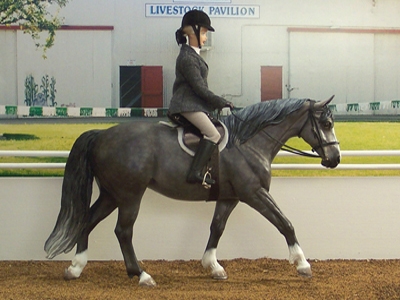
IMEHA Hunt Seat Equitation
Other Breed Entry
Ballyshannon shown as a Dark grey Connemara mare and is a Ballycor resin painted by Sherry Clayton. Shown by Robin Nere with the comment: Entering arena for Native Pony English Pleasure class. Connemara’s are shown unplaited and with legs not shaven.
Doll Rider Correct Seat and Hold the Reins Correctly:

The reins are held between the ring fingers and pinkies with the thumbs solidly on top as they exit the hands. The grip is firm. Close the fingers for optimum communication and safety. Hold the hands just above the horse’s withers, in front of the saddle. Tip the thumbs toward each other at a 45-degree angle. Bend the elbows just enough to create a straight line through the forearms, hands, and reins to the horse’s mouth.
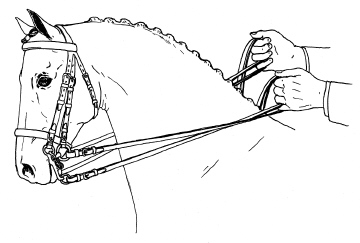
Double Bridle Reins – 2 and 2 Method. Most common handle hold in model horse hobby. It is advised that you put in your comment line what hold your set up is so that judge’s know you understand the three styles on holding the reins.

Double Bridle Reins – 3 in 1 Method. A true challenge for model horse hobbyists and doll rider’s with razor cut slips in the fingers of the hands. Left side curb goes directly back to hand and enters under ring finger with the left snaffle rein coming directly back and entering under the pinky finger with rein crossing over the curb rein. Right side curb rein goes directly back and enters under the middle finger of the left hand with all three reins coming up thru hand and out over the of the index finger with bight cascading down the right side. The right side snaffle goes directly and enters the hand under the ring finger, up into the hand and out over the top of the index finger with the bight draping down the right side. The look gives an ‘X’ to reins the left side of horse’s neck but a two independent rein look to the right side but only one rein going into the right hand. Very tricky set up.
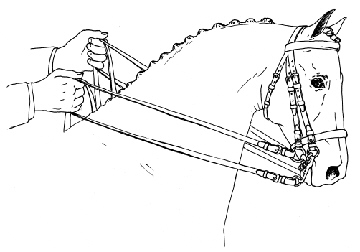
Double Bridle Reins – Fillis Method. The Fillis method of holding the reins is when the curb reins enter the rider’s hand from the bottom, around the little fingers and up to the second joint of the index fingers while the snaffle enters the fist from above over the index fingers. Each hand holds two reins.

